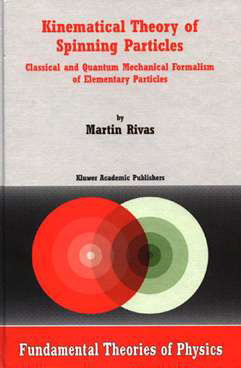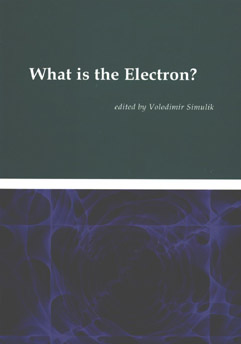The
spin structure of elementary particles has been considered a pure quantum
mechanical and relativistic property.
It is attributed to Pauli the statement that the spin cannot be explained
classically. But what Pauli said was that “the two-valuedness of
spin is a physical property which cannot be explained classically”,
i.e., the spin of elementary particles is quantized.
Please, see here what very
excellent quantum mechanics books say about the spin of the
electron.
The spin is an angular momentum and as such it is a mechanical property
related to the rotation invariance of the fundamental physical laws and
in this sense it has nothing to do with relativity. Any angular momentum
is a property defined with respect some fixed point and this point has
to be clearly identified. Dirac spin operator is not the angular momentum
of the particle with respect to the center of mass. It is clear that the
sum of the three spin observables associated to the quarks cannot give
the spin of the proton. We have to add the three angular momentum observables
of the quarks with respect to their centre of masses. See the discussion
concerning the generalized use of two
different spin observables for describing the angular momentum
of particles.
It is usually stated that the electron does not rotate. We see that all
matter which surrounds us moves and rotates. According to this the only
exception are the elementary particles. It is nonsense.
The electron has a directional property, the spin, and the associated
magnetic moment, which define a direction in space. These properties change
their orientation, and thus we associate to this change of orientation
a rotation of the electron.
What does not change is the absolute value of the spin. It is physically
impossible to modify the value of the spin of the electron. This has to
be raised to a fundamental physical law. Elementary particles, if not
annihilated, can never be modified its internal structure and therefore
they do not have excited states.
This
can be included as a complementary property of the Atomic Principle.
The atomic principle admits that matter cannot be divided indefinitely.
After a finite number of steps in the division of matter we reach an ultimate
object, an elementary particle. But the distinction between an elementary
particle and a bound system of particles is that an elementary particle,
if not annihilated with its antiparticle, can never be modified its structure
by any interaction. An electron, when accelerated, remains an electron.
This means that an elementary particle cannot have excited states and,
if not destroyed, its possible states are only kinematical modifications
of any one of them. If the state of an elementary particle changes, it
is possible to find another inertial observer who describes the particle
in the same state as before. For the description of an elementary particle
it is sufficient the description given by any arbitrary intertial observer.
It is the kinematical group of space-time symmetries (the kinematical
group) which supplies the classical variables for describing
its states.
See the following GEDANKEN
EXPERIMENT about the possibility of making a film about the
evolution of an elementary particle and
how its states can be described.
Find here a DIDACTIC DEMO of the proposed electron structure where you can analyze the interaction of two electrons, including the formation of a bound pair of spin 1.
For the numerical computation of the interaction between two spinning electrons, their scattering and the formation of bound pairs, you can use the Mathematica package ellaborated by Juan Barandiaran, entitled
Electron Collision Model for 2D spinning particles.
Lecture
Notes of the Kinematical formalism of elementary spinning particles (pdf)
Updated edition of the Lecture Notes, Bilbao March 2024
Considerations
about photons and antiphotons
(Indian
J. Phys 96 583-591 (2022).(pdf)
Rejected by the moderators of ArXiv
The
center of mass and center of charge of the electron
(J.
Phys:Conference Series 615 (2015) 012017)(print)
Is
General Relativity a restricted theory?
Videoconference talk delivered at Virtual Institute of
Astroparticle Physics (VIA)
January 30th, 2015.(Talk)
Is
General Relativity a restricted theory?
Lecture talk delivered at the Instituto de Astrofísica
de Canarias (IAC)
November 17th, 2014. (In Spanish) (Talk)
Is
General Relativity a v/c -> 0 limit of a Finsler geometry?
(Contribution
to the Spanish Relativity Meeting 2012,
Progress
in Mathematical Relativity, Gravitation and Cosmology
Guimaraes, Portugal Sept 3-7, 2012 Springer ISBN 978-3-642-40156-5) (print)
Is
General Relativity a simplified theory?
(J.
Phys:Conference Series 437 (2013) 012008) (print)
The
center of mass and center of charge of the electron
(arXiv:1211.3253)(abstract-arXiv)
Is
General Relativity a simpler theory?
(arXiv:1203.4076)(abstract-arXiv)
The mechanism of tunneling and formation of bound pairs of electrons (pdf)
Contribution to the ICTP 2011, Moscow Open University International Conference, June 20-24, 2011.
Proceedings published in Quantum Computers and Computing vol.11, 2011.
A lacking term in the proton spin (pdf)
Contribution to the SPIN-2010 Conference, Julich (Germany) Sept 27-Oct 3, 2010.
(J.
Phys:Conference Series 295 (2011) 012040) (print)
Measuring the internal clock of the electron
(arXiv:0809.3635)(abstract-arXiv)
On the kinematics of the centre of charge of a spinning particle
Contribution to the IARD08 Conference. Thessaloniki June 2008.
(arXiv:0807.2512)(abstract-arXiv)
Kinematical
formalism of elementary particles (pdf)
Lecture
Course delivered at the Department of Theoretical Physics
University of the Basque Country, Bilbao, June 2008
Kinematical
formalism of elementary spinning particles (pdf)
Lecture
Course delivered at the Center for Theoretical Physics
Jamia Millia Islamia, New Delhi, November 2007
The
atomic hypothesis: Physical consequences (pdf)
(J.
Phys. A: Math. and Theor. 41, 304022 (2008) )
(arXiv:0709.0192)(abstract-arXiv)
An
interaction Lagrangian for two spin 1/2 elementary Dirac particles (pdf)
(J.
Phys. A: Math. and Theor. 40, 2541 (2007) )
(hep-th/0702172)(abstract-arXiv)
Kinematical
theory of spinning particles: The interaction Lagrangian for two spin
1/2 elementary Dirac particles(pdf)
Plenary lectures of the Advanced Studies Institute, Symmetries
and Spin, Prague 19-26 July 2006.
(physics/0608089)(abstract-arXiv)
The interaction Lagrangian of two spin 1/2 elementary Dirac particles(pdf)
Contribution
to the Colloquium on Group Theoretical Methods on Physics CUNY NewYork,
26-30 June 2006
The
space-time symmetry group of a spin 1/2 elementary particle
(J. Phys. A: Math. and General 39,
4291 (2006) ) (pdf)
(hep-th/0511244)(abstract-arXiv)
Kinematical
formalism of elementary spinning particles
Lecture Course given at JINR, Dubna, 19-23 September 2005
(physics/0509131)
(abstract-arXiv)
The
dynamical equation of the spinning electron
(J. Phys. A: Math. and General, 36, 4703 (2003))
(pdf)
(physics/0112005) (abstract-arXiv)
Classical
elementary particles, spin, zitterbewegung and all that
(physics/0312107) (abstract-arXiv)
Space-time
structure of classical and quantum mechanical spin
(Czec.J.Phys. 52, C453 (2002))
(pdf)
Are
the electron spin and magnetic moment parallel or antiparallel vectors (pdf)
(physics/0112057) (abstract-arXiv)
Generalized
Lagrangians and spinning particles
Contribution to a special issue in the 200th Ostrogradskii anniversary
by the Ukrainian Mathematical Society
(Ukrainian Math. J. 53, 1326 (2001))
(pdf)
(physics/0106023)(abstract-arXiv)
A
pure kinematical explanation of the gyromagnetic ratio g=2 of leptons
and charged bosons
(Phys. Lett. A, 257, 21 (1999) )
(in collaboration with J.M. Aguirregabiria and A. Hernandez) (pdf)
Is
there a classical spin contribution to the tunnel effect?
(Phys. Lett. A, 248, 279 (1998)) (pdf)
Quantization
of generalized spinning particles. New derivation of Dirac’s equation
(J. Math. Phys. 35,3380 (1994)) (pdf)
Classical
relativistic spinning particles
(J. Math. Phys. 30,318 (1989)) (pdf)
Classical
particle systems: I Galilei free particle
(J. Phys. A: Math. and General, 18, 1971 (1985)
(pdf)
 |
Kinematical
theory of spinning particles. |
 |
The
spinning electron. |